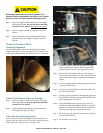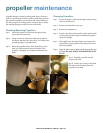
Step 1: Run the bilge blower for at least four (4) minutes to
ventilate the bilge area each time before starting the
engine.
Step 2: Inspect the boat bilge area under the engine for the
evidence of oil and gasoline—or any gasoline odor. is
inspection should take place the rst time the boat is
started each day. Raise the engine cover and visually
look at the bilge area under the engine.
Gasoline is explosive. If a gasoline odor is present or gasoline
is visually observed in the bilge area during inspection, DO NOT
START YOUR ENGINE! Remove the ignition key from the ignition
switch and call an authorized MasterCraft dealer for service.
Note: If there is evidence of loose fuel ttings, deteriorated lines
or other problems associated with the fuel system, call an au-
thorized MasterCra dealer. Fuel system service on later-model
MasterCra boats requires special service tools and special
training. Due to the potential for serious consequences when
errors occur in servicing the fuel system, MasterCra strongly
encourages all boat owners and operators to seek professional
assistance from an authorized MasterCra dealer’s service
department whenever any service or perceived problems occur
within the fuel system.
All replaced fuel components must meet United States Coast
Guard (“USCG”) and American Boat & Yacht Council, Inc.
(“ABYC”) standards, and must be Underwriter’s Laboratory
(“UL”)-approved. Inferior quality components pose a serious
safety threat to you and others, and the use of inferior compo-
nents may result in serious injury or death. Resulting damage
may void the warranty.
Fire Extinguisher and Suppression Units
MasterCra recommends that boat owners include a check of
the re suppression and extinguisher units during the annual
maintenance to be sure that they are always ready for use. Some
units may not require annual checks; refer to the signage and
labeling on the individual units for further guidance.
MasterCraft 2009 Owner’s Manual - Page 16-8


















